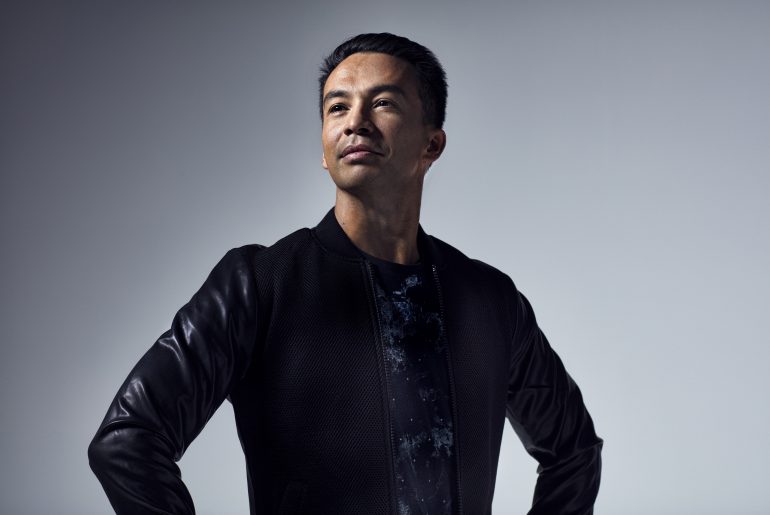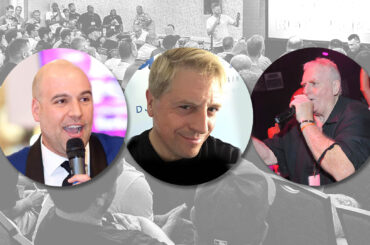Though he’s known mostly for his exploits in clubland, Lucas Cornelis van Scheppingen has always been a high-achiever, one with a purposeful approach to his life and work.
Born in The Philippines and raised in The Netherlands, the 41-year-old DJ/producer known professionally as Laidback Luke broke out big with memorable collaborations like 2008’s “Show Me Love” (with Steve Angello feat. Robin S), 2009’s “Leave the World Behind” (with Swedish House Mafia’s Axwell, Ingrosso and Angello feat. Deborah Cox), 2011’s “Turbulence” (with Steve Aoki feat. Lil Jon) and more recently 2017’s “XOXO” (with Ralvero feat. Ina) and “Paradise” (feat. Bright Lights). Additionally, Luke has remixed hits for some of the biggest artists in the business – Madonna, Mariah Carey, Robin Thicke and Nicki Minaj – not to mention some of electronic music’s most legendary talents – Daft Punk, Depeche Mode and Moby.
Also, as the founder of Mixmash Records, his talent-scout abilities are well-known. Over the years, those skills have delivered an astonishing array of hitmakers on their way up the ladder of success – they include Avicii, Bingo Players, Knife Party, Afrojack and Steve Angello, among others.
And he hasn’t stopped. When he’s not in the studio or touring the world – playing the biggest festival and club events (like his Super You & Me parties) – the Holland-based DJ/producer is often training in a martial-arts gym. A devout kung fu artist, especially devoted to the Choy Li Fut style, Luke engages international competitions. In fact, this past March in Hong Kong, Luke competed professionally in the Kung Fu World Championships, winning six medals (three gold, two silver and one bronze). The man is made of more than just 4/4 beats.
So, in a pair of interviews conducted this summer and spring, Laidback Luke tells his story of sustained success.
DJ Times: What was your initial musical inspiration?
Laidback Luke: I’ve always been intrigued with music and grew up with Pink Floyd and Mike Oldfield as electronic examples. But it was Technotronic’s “Pump Up the Jam” that I saw stemmed out on my friend’s Amiga computer back in 1992 that gave me my calling to start producing.
DJ Times: What about your getting into DJ culture?
Laidback Luke: It was my ex-wife, then girlfriend, that bought a full set-up to start taking up DJing. She tried it a couple of times, but quickly found out it wasn’t for her. With her set-up just sitting there in my studio, I decided to give it a go and found it really easy to get into with my producer background.
DJ Times: Do you remember that first DJ set-up?
Laidback Luke: The set-up my girlfriend bought included two Soundlab belt-drive vinyl players with a two-channel Numark mixer.
DJ Times: Was there a DJ that first caught your attention?
Laidback Luke: One of the first DJs that blew me away was Carl Cox. I saw him playing with three decks and adding scratching into it… which triggered me to become very technical.
DJ Times: As a DJ, at what point did you realize that you were good enough to play out in front of an audience?
Laidback Luke: I basically got thrown into it! By 1997, I only had played a year at home – just practiced a lot, though. But in that year, thanks to Carl Cox, who played my remix for Green Velvet’s “The Stalker” everywhere, my name became a hype. And thanks to people finding out, I DJed as well, I could instantly start getting shows. To be very honest, I was absolutely not ready to “rock the decks,” but I tried anyway.
DJ Times: What were your first DJ gigs like? Where did you play?
Laidback Luke: My first-ever show was in a place outside of London called Reading, at the techno party called Checkpoint Charlie. It was a small, sweaty club, where they did invite big DJs regularly.
DJ Times: What was your original production set-up?
Laidback Luke: Because I’m old-school, I did have quite the hardware studio setup. Most of it, Zki and Dobre—the duo also known as Chocolate Puma—gave to borrow since they had leftover equipment. Later, when I started making money from putting out tracks, I started to buy my own gear. In the end, I owned two Yamaha 01R mixers, DJ Sneak’s Roland TR-909 drumcomputer, an E-mu e6400 sampler, Roland JV-1080 synthesizer and a Nord Lead, to name a few.
DJ Times: What is your principal studio software platform now?
Laidback Luke: I currently work on Ableton Live, but in the 25 years I’ve been making music, I’ve moved from Tracker to Cubase to Logic to FL Studio and then onto Ableton. There are no real favorite plug-ins. I love everything by FabFilter and still use the [LennarDigital] Sylenth1, [Native Instruments] Massive and Korg M1 as my go-to synths. But I use a ton of stock Ableton plug-ins as well. I like keeping things simple.
DJ Times: With your years of production experience has your process evolved over time? Also, how has the public’s perception of producing changed?
Laidback Luke: I don’t think producing was that hard back in the day. I started producing on hardware back in 1992. Back then, tracks would simply be made with three pieces of kit – a drum machine, a synthesizer, and a sampler. If you were fancy, at most, you could add a mixer to that, and possibly an FX rack. Unfortunately, hardware was at least five times more expensive than VSTs are nowadays. Looking past cost, if you compare the production quality then and now, it has evolved so much. I mean, when I started there was no internet. When kids start now, there’s tons of online tutorials you can learn from. I think that helps a lot with learning to properly produce and in that sense, makes it easier for the masses nowadays.
DJ Times: You play a key role in the world of online tutorials and feedback. Despite your ambitions to lend a helping hand free of bias, hate tends to rear its head from time to time…
Laidback Luke: I think it has to do with envy and jealousy. It’s kids that haven’t got a shot, assuming that someone like me doesn’t know the hustle, doesn’t know how to fight for their place. They seem to think that success was always readily available to me, and that I’m not willing to give anyone a chance.
DJ Times: Seems like the farthest thing from the truth…
Laidback Luke: It’s sheer ignorance. I once was that same insecure kid with a lot of talent as well. The difference was I knew I was going to make it someday. Don’t be an asshole – that will take you nowhere. At least 50-percent of your opportunities will come from people granting you a chance. If you go around spreading hate, the opportunities won’t come. Mind you, you don’t need to kiss my ass in order to make it. But what a lot of ignorant kids don’t realize either is that I’m like a football coach – one that has been and still is a professional in this world. If you want to break through as a football player, why not take advice from the coach?
DJ Times: Looking back now, who’s production style originally inspired you?
Laidback Luke: When I first started learning to produce, again, Dobre from Chocolate Puma, who [with Zki] was famous under the moniker “The Goodmen,” guided me. He also pointed out who was making amazing stuff, and who I should listen to. He introduced me to the productions of DJ Pierre and Carl Craig, among others. Also, I’ve always loved MK’s stuff and Armand Van Helden. Later Daft Punk came into the picture as well as Timbaland. Oh, and before I got in touch with Dobre, I used to listen to a lot of The Prodigy as well.
DJ Times: In the same vein as what Dobre offered you—do you now have any advice for young headstrong producers?
Laidback Luke: Yes. For starters, if you want to keep on evolving, and humans need to evolve up until they die no matter how good they are, you will always need to be open to learning something new. The day you stop learning is the day you stop living.
DJ Times: Basically, evolve or die… how about when it comes to producers performing live like Flume, Deadmau5 or Madeon?
Laidback Luke: I have no problem with producers performing live. I think that’s what producers should do. If you are a producer that doesn’t get past basic DJing or pre-recorded sets and pre-fab mashups, you’re just a poor excuse of a DJ. DJing is such a fine art with such
depth, and when performed correctly, so much more powerful than a lot of the mediocre, top-name producer sets we get. It’s tough – I’m a producer by heart, too. I was already producing for four years before I started DJing. I’d advise any producer to stick about as much time into learning the real art of DJing as they did with learning the art of producing.
DJ Times: What happens to fledgling DJs who find themselves stuck attempting to produce. Those who succumb to writer’s block and do not believe they can create anything that sounds new—how do you fight the notion you have nothing new to offer?
Laidback Luke: Don’t worry about that. When trying to re-invent the wheel you’ll always run up against a wall. Guess what? The wheel has already been invented. There’s no need to re-invent the entire system. Just try and be you, because everyone is unique. If you just look inwards and dive deep into yourself—what’s really you, and what you stand for—that unique sound will flow out of you naturally.
DJ Times: In producing your own music and playing it out, how important is it to not get bogged down by a single element, be it a drop or the hook?
Laidback Luke: Whenever I consider picking a track to play live and I don’t like the drop or the hook, it could end up being a deal-breaker for me. Whenever I look at my tracks, everything needs to make sense. What doesn’t make sense is to EQ a hi-hat for eight hours, or to EQ a reverb for four. I’ve done that, and there’s just no use for it – it doesn’t help anything. Nonetheless, things that are as clear and prominent, as a drop or a hook, should be done properly. Those are fundamental to a track.
DJ Times: In terms of live song selection, there are obviously specific tracks which you produced that you would regard as off limits for opening DJs. How would Laidback Luke’s guide to a perfect opening set read?
Laidback Luke: Actually, I did a video blog called “The Art of the Warm Up DJ.” Basically, a perfect opening set should feel like a good massage. It is meant to get the crowd in the mood… but without playing bangers. Tease them a little bit, keep the energy low. Get the girls dancing and grooving, not raging. I mean, you can play some vocally stuff, just stay away from the obvious hits—don’t play any of the headliner’s tracks! Even if you see playing their track as a sign of respect, you just need to know it’s the most disrespectful thing you can do to a headliner.
DJ Times: Speaking of live shows, you became an ambassador for Denon DJ’s Prime Series. Looking ahead, you will be touring with a new set up: SC5000 Prime media player and X1800 Prime club mixer. Tell us about that development…
Laidback Luke: I’m very proud and excited for it to be honest. Everywhere I go from here on, I’ll be playing on the Denon Prime Series equipment. It’s a whole new chapter for me because Denon has a ton of new features that will give me endless possibilities. It’s up to me now to find new ways into the nuances of the equipment to really make it my own. I am currently practicing every day and everything feels really intuitive.
DJ Times: Regardless of your set-up, connecting with your audience is key. Do you have any favorite venues where you feel like you are most able to get across your musical message?
Laidback Luke: I don’t, actually. Honestly, every venue represents another challenge for me. Even returning to the same venue, you never know what kind of crowd you are going to get. That’s the beauty of what I do. To be able to adapt to the crowd, the environment, the time of year, the energy, and even the booth itself—that’s what makes DJing exciting. It’s still a pleasant challenge for me even after two decades.
DJ Times: Your single, “XOXO,” which you have professed was produced for radio, was well-received earlier this year. What is it about “XOXO” that plays so well to a live audience?
Laidback Luke: I don’t actually know. To be honest, I only started dropping it because we needed live footage of it for social media. But, literally the first time I dropped it, it went over so amazingly well. My mouth literally fell wide open… the only thing I can think of is that Future Bass as a sound is really happening right now.
DJ Times: From a technical standpoint, did you have an end goal in mind when you began producing that tune?
Laidback Luke: Sometimes when producing you have the end goal in mind, others you just follow the music. When playing with different sounds you often reach your end goal naturally. A lot of times you end up stumbling over tiny mistakes and if you use those properly you will find that you can add an awesome layer of creativity to a track. I used to make tracks by just starting to play around with a preset sound out of a synth and then tweaking it and playing melodies with it. But often that takes up a huge amount of time which I don’t have too much of these days. So recently, to save me a lot of time, and allow myself to still be a family man, I do mostly plan my tracks out conceptually with a finished product in mind.
DJ Times: “XOXO” is unabashedly full of pop sensibilities. Within the production community, do you see a sense of prestige and entitlement held by those who make more complicated tracks and stray away from the mainstream?
Laidback Luke: Yes, I guess so – but what does that get you? Nothing is stronger than a song that sticks in your brain and gives you goosebumps. I don’t even remember when I last had goosebumps from listening to an abstract track with all farty sounds that were so-called made from scratch. A lot of times people think about producing too complicatedly, they lose sight of the plot. It’s almost like those super fancy chefs who make these amazing meals that consist of one bite. Afterwards, you get some junk food to make you feel full anyway. A lot of young producers try to be that chef, most of the time it is just very unnecessary.
DJ Times: Looking at the full spectrum of production styles, which artists currently stand out to you?
Laidback Luke: It’s such a different time nowadays. Everything sounds amazing, yet everything sounds the same. Everything sounds super-polished and loud, yet nothing really stands out. It’s crazy times, if you ask me. I miss the times we had people like Neptunes, old Daft Punk, or even Basement Jaxx to blow us away. I might just finally be getting old, though…
DJ Times: There must be some that you admire still…
Laidback Luke: I still look up and admire the people who I’ve always looked up to – people that influenced my DJing like Jeff Mills, Dave Clarke, Bad Boy Bill and Frankie Bones. I’m still in awe by amazing turntablists like QBert, Jazzy Jeff, A-Trak and Craze. I’m very much not impressed by anyone that’s a DJ and stands on the DJ booth or in front of their private jet on Instagram.
DJ Times: You’ve earned your reputation as quite a talent scout. What are you looking for in a DJ/producer?
Laidback Luke: Obviously, the right tracks, but I often take on producers that haven’t fully developed yet. In that case, I’m looking for humble and open people that are willing to work hard. We really put high standards onto our talent. Sadly enough—and I hate it, too—but DJ skills aren’t enough. We really need to have tracks to be able to spread the name internationally.
DJ Times: What’s the key to running a successful music label today?
Laidback Luke: In my case, it’s having a good team with people that know about their specialty and that are very passionate about it. People that do a half-job can never operate on a high level. Finding the right people is tough, though!
DJ Times: In your experience, how has your artistic approach changed? To what extent has your creative process or music influence evolved?
Laidback Luke: When I started my career I was mainly underground house and tech-house. That later became very specialist with my love for techno. This certain niche killed me as an artist. It was too limited, as to what I was capable of as a musician – i.e., coming up with good leads, using chord progressions, making songs, using vocals. So after I broke with techno, I became more all-round as a producer. In 2004, I was doing so much of my own thing and I hit another wall. I realized no one was into what I was doing… or getting what I was doing. I was making music purely for myself at that point. And all of a sudden it clicked that it has to be a 50/50 thing: Keeping the audience in mind and blending it with what you want as an artist as well.
DJ Times: Why have the Dutch become so successful in DJ/dance-music culture? Why did that take off so much in The Netherlands?
Laidback Luke: We’ve always had a strong dance culture from the start, so that has always been deeply rooted. I do think one of the main things that kept the quality high is the Dutch crowd and mentality. The Dutch crowd is super-picky and, if you screw up or deliver less quality, even if they are your biggest fans, they’ll tell you in your face. Another thing that helps is that the Dutch are very smart when it comes to doing business. Overall, very professional – and even cunning, I’d say.
DJ Times: Why do you think dance music and DJ culture have become such a global phenomenon? After years of essentially ignoring it, even the U.S. has gotten into the act in recent years…
Laidback Luke: Even the Chinese are getting onto it now! I think dance music can be understood by everyone. It’s the native rhythm and moving to beats that can appeal to anyone. Becoming a DJ is relatively easy, especially when you compare it to bands onstage or anything else on stage. Try becoming a stand-up comedian and compare it to what most Top 10 DJs have to offer when it comes to skills…
DJ Times: In the U.S., anyway, it seems that this music and culture has spread via internet and festivals, as opposed to clubbing. Younger fans here don’t seem to have the attention spans that clubbers/ravers once had, in terms of trusting the DJ to take them on a journey. These days, the kids want instant gratification and tunes they know. How does a DJ react to that?
Laidback Luke: I’ve noticed that and I have been one of the first DJs to play sets like that—so I’m partially to blame! I’ll still have the journey in there, though, but on a much more explosive level. Dance music has become very poppy as well now. So in order for the mainstream crowd to get it and to keep them occupied, you’ll need to give them sets like that.
DJ Times: How do you balance your musical career and your immersion into martial arts? Does one side help the other?
Laidback Luke: Both sides complement each other. Through crashing and burning, I’ve learned that a fit life is highly beneficial for your stress levels and, obviously, you feel much better in a healthy body. I make working out and eating mindfully a top priority every day. My workouts aren’t long… just 45 minutes to an hour a day, but they set me off into the day fully energized!
DJ Times: What’s next for you and what keeps you excited about DJing and producing?
Laidback Luke: What’s next for me is a new album in the making, but I’m particularly excited about the VLOGs and video tutorials I’m making right now. You can find those on my Youtube Channel under “Laidback Luke.” With my long career, I have so much experience I can share, and I still thrive on helping people out.
DJ Times: If you were to give advice to our DJ/readers on how to carve out a successful career of making music and DJing, what would it be?
Laidback Luke: Have a vision, have a dream, and then do anything you can to sculpt that out over a course of five or 10 years. No matter what people will say to you, or how many setbacks you have, work hard and work smart to make your dream come true!







